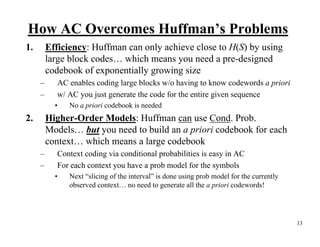Ad
Ch 04 Arithmetic Coding (Ppt)
- 1. Ch. 4 Arithmetic Coding 1
- 2. Motivation – What are Problems w/ Huffman 1. Can be inefficient (i.e., large redundancy) • This can be “solved” through Block Huffman • But… # of codewords grows exponentially See Example 4.2.1: H1(S) = 0.335 bits/symbol But using Huffman we get avg length = 1.05 bits/symbol Would need block size of 8 6561-symbol alphabet to get close to H1 2. High-Order Models (Non-IID) Hard to Address • Can be solved through Block Huffman • But # of codewords increases exponentially Underlying difficulty: Huffman requires keeping track of codewords for all possible blocks We need a way to assign a codeword to a particular sequence w/o having to generate codes for all possible sequences 2
- 3. Main Idea of Arithmetic Coding 1 Sequence: S1 S2 S3 S4 …. Mapped to… 0.6457351…. Each possible sequence gets mapped 0 to a unique number in [0,1) • The mapping depends on the prob. of the symbols • You don’t need to a priori determine all possible mappings – The Mapping is “built” as each new symbol arrives Recall CDF of an RV: symbols {a1,a2, a3} RV X w/ values: {1, 2, 3} Consider P(X=1) = 0.7 P(X=2) = 0.1 P(X=1) = 0.2 FX(x) 1 0.8 0.7 0 1 2 3 x 3
- 4. Example: “Vowellish” (from Numerical Recipes Book) To send “iou”: Send any # C such that 0.37630 ≤ C < 0.37819 Using Binary Fraction of 0.011000001 (9 bits) 9 bits for Arithmetic vs 10 bits for Huffman ⎧ upper limit ⎫ As each symbol is processed find new ⎨ ⎬ for interval ⎩lower limit ⎭ 4
- 5. Math Result Needed to Program Consider a sequence of RVs X = (x1, x2, x3, … , xn) corresponding to the sequence of symbols (S1, S2, S3, … , Sn) Ex. Alphabet = {a1 , a2 , a3 } → RV Values {1, 2, 3} ( S1 S2 S3 S4 ) = ( a2 a3 a3 a1 ) → ( x1 x2 x3 x4 ) = (2 3 31) Initial Values: l (0) = 0 u (0) = 1 Interval Update: l ( n ) = l ( n −1) + ⎡ u ( n −1) − l ( n −1) ⎤ F ( x − 1) ⎣ ⎦ X n u ( n ) = l ( n −1) + ⎡u ( n −1) − l ( n −1) ⎤ FX ( xn ) ⎣ ⎦ From Prev Interval From Prob Model 5
- 6. Checking Some Characteristics of Update • What is the smallest l(n) can be? ( n −1) l ( n ) = l ( n −1) + ⎡u ( n −1) − l ( n −1) ⎤ FX ( xn − 1) ⎣ ⎦ l (n) ≥l >0 ≥0 • What is the largest u(n) can be? u ( n ) = l ( n −1) + ⎡u ( n −1) − l ( n −1) ⎤ FX ( xn ) ⎣ ⎦ ( n −1) ≤1 u (n) ≤u ≤l ( n −1) + ⎡u ⎣ ( n −1) −l ( n −1) ⎤ ⎦ These imply an important requirement for decoding: New Interval ⊆ Old Interval 6
- 7. Example of Applying the Interval Update Symbols {a1,a2, a3} RV X w/ values: {1, 2, 3} Consider P(X=1) = 0.7 P(X=2) = 0.1 P(X=1) = 0.2 FX(x) 1 0.8 CDF for this 0.7 alphabet/RV 0 1 2 3 x Consider the sequence (a1 a3 a2) → (1 3 2) To process the first symbol “1” FX(0) l (1) = l (0) + ⎡u (0) − l (0) ⎤ FX (1 − 1) = 0 + [1 − 0] × 0 = 0 ⎣ ⎦ u (1) = l (0) + ⎡u (0) − l (0) ⎤ FX (1) ⎣ ⎦ = 0 + [1 − 0] × 0.7 = 0.7 FX(1) 7
- 8. To process the 2nd symbol “3” FX(2) l (2) = l (1) + ⎡u (1) − l (1) ⎤ FX (3 − 1) = 0 + [0.7 − 0] × 0.8 = 0.56 ⎣ ⎦ u (2) = l (1) + ⎡u (1) − l (1) ⎤ FX (3) ⎣ ⎦ = 0 + [0.7 − 0] × 1 = 0.7 FX(3) To process the 3rd symbol “2” FX(1) 1010101000 l (3) = l (2) + ⎡u (2) − l (2) ⎤ FX (2 − 1) = 0.56 + [0.7 − 0.56] × 0.7 = 0.658 ⎣ ⎦ u (3) = l (2) + ⎡u (2) − l (2) ⎤ FX (2) ⎣ ⎦ = 0.56 + [0.7 − 0.56] × 0.8 = 0.672 FX(2) So… send a number in the interval [0.658,0.672) Pick 0.6640625 0.664062510 = 0.10101012 Code = 1 0 1 0 1 0 1 8
- 9. Decoding Received Code = 1 0 1 0 1 0 1 ⎧0.1111111... = 1 ⎧0.1011111... = 0.75 1→ ⎨ 10 → ⎨ ⎩0.1000000... = 0.5 ⎩0.1000000... = 0.5 1 1 a3 a3 0.8 0.8 a2 After 1st bit [0.5 1)… a2 0.7 Can’t Decode 0.7 After 2nd bit [0.5 0.75)… Can’t Decode… But first symbol can’t be a3 a1 a1 0 0 9
- 10. Decoding Continued: Received Code = 1 0 1 0 1 0 1 ⎧0.1011111... = 0.75 ⎧0.1010111... = 0.6875 101 → ⎨ 1010 → ⎨ ⎩0.1010000... = 0.625 ⎩0.1010000... = 0.625 1 1 a3 a3 0.8 0.8 a2 [0.625 , 0.75)… a2 0.7 Can’t Decode 0.7 0.7 [0.625 , 0.6875)… a3 Can Decode 1st symbol!!! a2 0.56 It is a1 0.49 Now slice up [0, 0.7)… a1 a1 a1 …can decode 2nd symbol It is a3 0 0 0 10
- 11. Decoding Continued: Received Code = 1 0 1 0 1 0 1 ⎧0.1010111... = 0.6875 ⎧0.10101011... = 0.671875 10101 → ⎨ 101010 → ⎨ ⎩0.1010100... = 0.65625 ⎩0.10101000... = 0.65625 0.7 0.7 [0.65625 , 0.6875)… [0.65625, 0.671875)… 0.672 0.672 Can’t Decode Can’t Decode 0.658 0.658 0.56 0.56 ⎧0.1010101111... = 0.671875 1010101 → ⎨ ⎩0.1010101000... = 0.6640625 0.7 [0.6640625, 0.671875) 0.672 Can Decode 3rd symbol!!! 0.658 It is a2 0.56 In practice there are ways to handle termination issues! 11
- 12. Main Results on Uniqueness & Efficiency 1. A “binary tag” lying between l(n) and u(n) can be found 2. The tag can be truncated to a finite # of bits 3. The truncated tag still lies between l(n) and u(n) 4. The truncated tag is Unique & Decodable 5. For IID sequence of length m: H ( S ) ≤ l < H ( S ) + 2 Arith m 1 Compared to Huffman: H ( S ) ≤ lHuff < H (S ) + m Hey! AC is worse than Huffman??!! So why consider AC???!!! Remember, this is for coding the entire length of m symbols… You’d need 2m codewords in Huffman… which is impractical! But for AC is VERY practical!!! For Huffman must be kept small but for AC it can be VERY large! 12
- 13. How AC Overcomes Huffman’s Problems 1. Efficiency: Huffman can only achieve close to H(S) by using large block codes… which means you need a pre-designed codebook of exponentially growing size – AC enables coding large blocks w/o having to know codewords a priori – w/ AC you just generate the code for the entire given sequence • No a priori codebook is needed 2. Higher-Order Models: Huffman can use Cond. Prob. Models… but you need to build an a priori codebook for each context… which means a large codebook – Context coding via conditional probabilities is easy in AC – For each context you have a prob model for the symbols • Next “slicing of the interval” is done using prob model for the currently observed context… no need to generate all the a priori codewords! 13
- 14. Ex.: 1st Order Cond. Prob Models for AC Suppose you have three symbols and you have a 1st order conditional probability model for the source emitting these symbols… For the first symbol in the sequence you have a std Prob Model For subsequent symbols in the sequence you have 3 context models P ( a1 ) = 0.2 P ( a1 | a1 ) = 0.1 P ( a1 | a2 ) = 0.95 P ( a1 | a3 ) = 0.45 P ( a2 ) = 0.4 P ( a2 | a1 ) = 0.5 P ( a2 | a2 ) = 0.01 P ( a2 | a3 ) = 0.45 P ( a3 ) = 0.4 P ( a3 | a1 ) = 0.4 P ( a3 | a2 ) = 0.04 P ( a3 | a3 ) = 0.1 ∑ P(a ) = 1 ∑ P(a i i i i | a1 ) = 1 ∑ P(a i i | a2 ) = 1 ∑ P(a i i | a3 ) = 1 Now let’s see how these are used to code the sequence a2 a1 a3 Note: Decoder needs to know these models 14
- 15. P ( a1 ) = 0.2 P ( a1 | a2 ) = 0.95 P ( a1 | a1 ) = 0.1 P ( a2 ) = 0.4 P ( a2 | a2 ) = 0.01 P ( a2 | a1 ) = 0.5 P ( a3 ) = 0.4 P ( a3 | a2 ) = 0.04 P ( a3 | a1 ) = 0.4 1 0.6 a3 a2 a1 0.2 0 15
- 16. Ex.: Similar for Adaptive Prob. Models • Start with some a priori “prototype” prob model (could be cond.) • Do coding with that for awhile as you observe the actual frequencies of occurrence of the symbols – Use these observations to update the probability models to better model the ACTUAL source you have!! • Can continue to adapt these models as more symbols are observed – Enables tracking probabilities of source with changing probabilities • Note: Because the decoder starts with the same prototype model and sees the same symbols the coder uses to adapt… it can automatically synchronize adaptation of its models to the coder! – As long as there are no transmission errors!!! 16

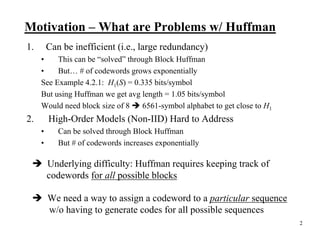
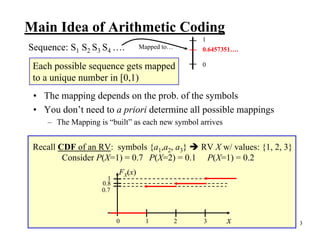
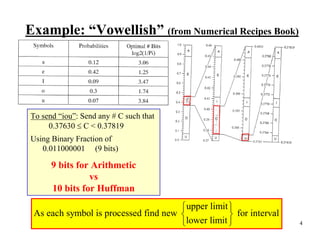
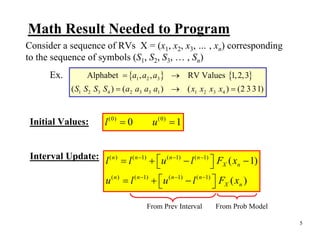

![Example of Applying the Interval Update
Symbols {a1,a2, a3} RV X w/ values: {1, 2, 3}
Consider P(X=1) = 0.7 P(X=2) = 0.1 P(X=1) = 0.2
FX(x)
1
0.8
CDF for this 0.7
alphabet/RV
0 1 2 3 x
Consider the sequence (a1 a3 a2) → (1 3 2)
To process the first symbol “1”
FX(0)
l (1) = l (0) + ⎡u (0) − l (0) ⎤ FX (1 − 1) = 0 + [1 − 0] × 0 = 0
⎣ ⎦
u (1) = l (0) + ⎡u (0) − l (0) ⎤ FX (1)
⎣ ⎦ = 0 + [1 − 0] × 0.7 = 0.7
FX(1) 7](https://image.slidesharecdn.com/ch04arithmeticcodingppt-100208225214-phpapp02/85/Ch-04-Arithmetic-Coding-Ppt-7-320.jpg)
![To process the 2nd symbol “3”
FX(2)
l (2) = l (1) + ⎡u (1) − l (1) ⎤ FX (3 − 1) = 0 + [0.7 − 0] × 0.8 = 0.56
⎣ ⎦
u (2) = l (1) + ⎡u (1) − l (1) ⎤ FX (3)
⎣ ⎦ = 0 + [0.7 − 0] × 1 = 0.7
FX(3)
To process the 3rd symbol “2”
FX(1)
1010101000
l (3) = l (2) + ⎡u (2) − l (2) ⎤ FX (2 − 1) = 0.56 + [0.7 − 0.56] × 0.7 = 0.658
⎣ ⎦
u (3) = l (2) + ⎡u (2) − l (2) ⎤ FX (2)
⎣ ⎦ = 0.56 + [0.7 − 0.56] × 0.8 = 0.672
FX(2)
So… send a number in the interval [0.658,0.672) Pick 0.6640625
0.664062510 = 0.10101012 Code = 1 0 1 0 1 0 1
8](https://image.slidesharecdn.com/ch04arithmeticcodingppt-100208225214-phpapp02/85/Ch-04-Arithmetic-Coding-Ppt-8-320.jpg)




